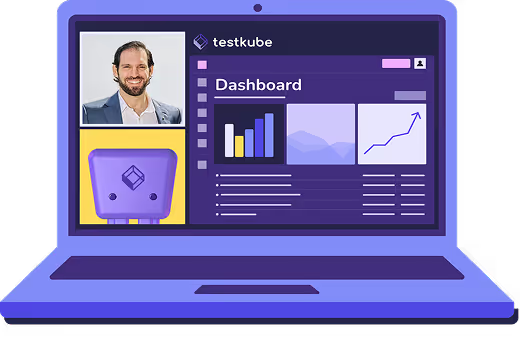Table of Contents
What Does Kubernetes-Native Testing Mean?
As applications migrate into Kubernetes environments, running tests externally, whether on SaaS platforms or separate testing servers, often creates significant inefficiencies and mismatched environments that undermine testing effectiveness. Kubernetes-native testing solves these challenges by executing tests directly within the Kubernetes cluster itself, leveraging core Kubernetes primitives like pods, jobs, and Kubernetes scheduling mechanisms to create a seamless testing experience.
Core Principles of Kubernetes-Native Testing
Kubernetes-native testing represents a fundamental shift in how teams approach testing containerized applications and microservices. Rather than treating the Kubernetes cluster as merely a deployment target, this methodology treats it as the testing environment itself, ensuring complete alignment between testing and production conditions.
Key benefits include:
- Environment consistency – tests run under the same infrastructure conditions, networking configurations, and resource constraints as production workloads, eliminating the "works in test but fails in production" problem
- Resource efficiency – dynamic scaling with Kubernetes resource allocation policies, allowing test workloads to scale up during peak testing periods and scale down when idle, optimizing infrastructure costs
- Isolation – each test suite or test execution runs in its own isolated pod or container, preventing test interference and ensuring reproducible results across test runs
- Observability – seamless integration with Kubernetes-native logging systems (like Fluentd or Loki), monitoring solutions (like Prometheus), and distributed tracing tools, providing deep visibility into test execution
- Security – automatically leverages Kubernetes Role-Based Access Control (RBAC), network policies for traffic segmentation, and Kubernetes secrets management for secure credential handling during test execution
Implementation Approaches
Kubernetes-native testing typically involves several technical approaches that maximize the platform's native capabilities:
- Executing tests in dedicated pods – Each test suite runs as a containerized workload within the cluster, with full access to cluster resources and services
- Distributing tests across multiple nodes in parallel – Large test suites can be automatically distributed across worker nodes for faster execution, taking advantage of horizontal scaling
- Using namespaces for environment isolation – Different testing stages (unit, integration, end-to-end) or different teams can operate in isolated namespaces, preventing resource conflicts
- Managing configuration via ConfigMaps and Secrets – Test configuration, environment variables, and sensitive credentials are managed using Kubernetes-native constructs
- Collecting results directly via Kubernetes APIs – Test results, logs, and artifacts are gathered using standard Kubernetes APIs, enabling integration with existing observability stacks
Why Kubernetes-Native Testing Matters
Testing outside Kubernetes introduces significant risks, including environment drift, configuration mismatches, and blind spots that only surface in production—especially critical when dealing with complex microservices architectures. Kubernetes-native testing ensures:
- Accurate validation in production-like environments – Tests interact with the same service mesh, network policies, storage classes, and resource limits that production workloads encounter
- Seamless integration with DevOps and GitOps workflows – Testing becomes a natural part of CI/CD pipelines, with test execution triggered by the same GitOps operators that manage deployments
- Scalable execution that matches application demand – As your application scales across clusters and regions, your testing infrastructure scales with it using the same orchestration mechanisms
- Better debugging, monitoring, and security alignment – Test failures can be investigated using the same tools (kubectl, logs, metrics) that DevOps teams already use for production troubleshooting
- Reduced infrastructure complexity – Eliminates the need to maintain separate testing infrastructure, reducing operational overhead and potential points of failure
Common Challenges and Solutions
While Kubernetes-native testing offers substantial benefits, teams should be aware of several challenges:
- Resource contention – Test workloads competing with application workloads for cluster resources, which can be managed through resource quotas and priority classes
- Managing ephemeral test environments – Creating and tearing down isolated test environments efficiently requires proper namespace management and cleanup automation
- Aggregating distributed results – Collecting and consolidating results from tests distributed across multiple pods and nodes demands robust result aggregation strategies
- Debugging containerized test failures – Troubleshooting failures in short-lived containers requires enhanced logging strategies and the ability to preserve test artifacts
Real-World Examples and Use Cases
Understanding how teams apply Kubernetes-native testing in practice helps illustrate its value:
- A microservices team at a large e-commerce platform deploys automated smoke tests and load tests directly inside their Kubernetes cluster. Testkube orchestrates each test suite as an isolated pod, distributes load testing execution in parallel across multiple nodes to simulate thousands of concurrent users, and aggregates performance metrics and test results into a centralized dashboard for team visibility.
- A cloud-native SaaS platform uses Kubernetes-native testing to continuously validate complex infrastructure configurations including service mesh routing rules (Istio/Linkerd), ingress controller policies (NGINX/Traefik), mutual TLS certificate rotation, and Horizontal Pod Autoscaler (HPA) policies under realistic load conditions. This ensures that infrastructure changes don't introduce regressions before reaching production.
- A financial services company runs compliance and security tests as Kubernetes CronJobs, executing automated penetration testing, vulnerability scanning, and policy validation on a scheduled basis directly within their production Kubernetes clusters, ensuring continuous compliance monitoring.
How Kubernetes-Native Testing Works with Testkube
Testkube is purpose-built for Kubernetes-native testing, designed from the ground up to leverage Kubernetes as a first-class testing platform. It provides:
- Native Kubernetes scheduling – Testkube schedules tests as Kubernetes Jobs or pods directly within the cluster, using the same scheduling mechanisms that orchestrate application workloads
- Distributed and parallel execution – Automatically distributes test suites across available nodes, enabling parallel execution that dramatically reduces overall test execution time for large test suites
- Centralized reporting and observability – Provides a unified dashboard for viewing test results, logs, and artifacts from all test executions, regardless of where they ran in the cluster
- Artifact storage and management – Automatically collects and stores test artifacts (logs, screenshots, videos, reports) with configurable retention policies
- Deep Kubernetes integration – Seamlessly integrates with Kubernetes monitoring solutions (Prometheus, Grafana), security policies (Pod Security Standards, Network Policies), and RBAC configurations
- Extensive test framework support – Works with popular testing frameworks including Postman, k6, Playwright, Cypress, JMeter, Gradle, Maven, and custom test executors
- GitOps-friendly – Tests can be defined as Custom Resources (CRDs) and managed through GitOps workflows using tools like ArgoCD or Flux
By running tests where your applications run, Testkube ensures that your testing strategy scales alongside your Kubernetes infrastructure, providing confidence that your applications will perform reliably in production.
Getting Started with Kubernetes-Native Testing
Organizations looking to adopt Kubernetes-native testing should consider:
- Starting with smoke tests and basic health checks executed as Kubernetes Jobs
- Gradually expanding to integration tests that validate service-to-service communication within the cluster
- Implementing automated test execution triggered by deployment events using Kubernetes webhooks
- Establishing clear resource quotas and limits for test workloads to prevent cluster resource exhaustion
- Integrating test results into existing CI/CD pipelines and observability dashboards
Kubernetes-native testing represents the evolution of testing practices for cloud-native applications, aligning testing infrastructure with deployment infrastructure to create a more reliable, efficient, and maintainable testing strategy.




